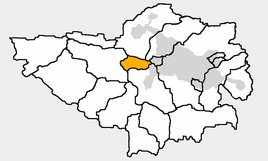Jechaburg
|
Jechaburg
District town Sondershausen
Coordinates: 51 ° 22 ′ 23 ″ N , 10 ° 50 ′ 9 ″ E
|
|
|---|---|
| Height : | 292 (227-298) m |
| Incorporation : | July 1, 1950 |
| Postal code : | 99706 |
| Area code : | 03632 |
|
Location of the Jechaburg district
in Sondershausen |
|
|
The St. Petri Church in Jechaburg.
|
|
Jechaburg is a district of Sondershausen in the Kyffhäuserkreis . The village was first mentioned on June 14, 1004 and was incorporated in 1950.
Geographical location
The village is located on the steep southern slope of the Frauenberg , west of Sondershausen and its district Stockhausen .
history
Documented names are: Gigenburg, Jecheburc, Jecheburch, Jechenburgk and Jichenburg.
The name probably goes back to the Germanic goddess Jecha , who was probably once a place of worship on the high plateau of the Frauenberg. Jecha was the goddess of the hunt, especially revered in Thuringia (word related to hunt; jach = fast). In connection with the name there is also a castle that is said to have been on the mountain and was built by King Ludwig III. rebuilt or restored around 878. According to the local researcher Friedrich Apfelstedt , it could also have been a pre-Christian Hünenburg . Only vague rudiments of protective walls are evidence of it.
In the course of Christianization in 714, Bonifatius , the "Apostle of the Germans", desecrated the site and the residents were forcibly converted. Instead of the depictions of idols , the Marienkapelle “Our dear women”, which was probably built in 878 by King Ludwig III. and from which the Frauenberg takes its name.
Richly furnished Franconian aristocratic graves were found on the Frauenberg.
In 989 the Archbishop of Mainz Willigis founded a Benedictine monastery in Jechaburg . With the consent of the Pope, this was elevated to the monastery of St. Peter and Paul in 1004 . In its heyday as an archpriesthood , it had eleven deaneries , 1,000 churches, chapels and monasteries under itself.
In the 14th century a three-aisled collegiate church with ten to thirteen altars was built in Jechaburg. The Wormser bishop Eberwin I. Kronberg († 1303) was in 1299, at its option, here provost . From the 15th century, church grievances led to an alienation of the population from the church. The consequence was the loss of prestige and power of the Archdeaconate of Jechaburg. On April 30, 1525, in the course of the peasant war, an angry mob of farmers and citizens from Sondershausen and the surrounding area raged in Jechaburg under the leadership of Klaus Haske . They invaded the provost house and left chaos and devastation. The looting and destruction fell victim to invaluable cultural and historical evidence, including irreplaceable documents, that were valuable for posterity. The Ludowingers were temporarily bailiffs of the Jechaburg monastery. With this bailiwick, they expanded their influence in the northern Thuringian region. In 1552 the deanery was under Count Günther XL. from Schwarzburg Protestant.
The last provost of the Jechaburg archdeaconate was Count Johann Günther (1532–1586) from the house of the Schwarzburger . He was also the founder of the later prince line Schwarzburg-Sondershausen .
In 1572 or 1592 the monastery was secularized, ie part of the income was used to pay teachers and clergymen, and most of the land was combined with the Vorwerke of Stockhausen and Sondershausen.
Today, not even ruins testify to the extensive canon monastery. The collegiate church gradually fell into disrepair, so that the stones were ruthlessly used as building material for houses in Jechaburg and Sondershausen. At the corner of the old monastery tower that is still preserved today, the current small village church was built in 1726 under Prince Günther I von Schwarzburg-Sondershausen, which was the mother church of Bebra and Stockhausen until the end of the 19th century . She carries a memorial plaque to Albrecht von Halberstadt . He was a famous member of the monastery, who also made a name for himself as a minstrel and spent 40 years here. He is considered the oldest poet of the Wippertal and is the translator here of the " Metamorphoses of Ovid " from Latin into Middle High German . With numerous similar translations he made a major contribution to the development of the German language.
In 1873 Thilo Irmisch led an excavation on the Frauenberg to research the building history of the former Jechaburg monastery.
Until 1918 the place belonged to the rule of the principality Schwarzburg-Sondershausen . On July 1, 1950, Jechaburg was finally incorporated into Sondershausen.
Attractions
- A linden tree that is over 500 years old and is located opposite today's St. Petri Church is a natural monument .
- Club house, half-timbered building, probably built around 1650
Personalities
- Günther Pöschel (* 1933), the rear admiral of the People's Navy , long-time commander of the naval forces section at the Friedrich Engels military academy of the NVA in Dresden and associate professor was born in what is now the district of Sondershausen
literature
- Stock houses church reports by Karl Möller
- First mention of Thuringian cities and villages up to 1300; Ed .: Harald Rockstuhl, 2001, ISBN 3-934748-58-9
- Declaration of love to a city - Sondershausen, Ed .: Image archive Röttig, 2000
- Architectural and art monuments of the principality of Schwarzburg-Sondershausen, first issue: Die Unterherrschaft, 1886, author: F. Apfelstedt
Web links
Individual evidence
- ^ Friedhelm Jürgensmeier : The Diocese of Worms from Roman times to its dissolution in 1801 , Echter Verlag, Würzburg, 1997, ISBN 3-429-01876-5 , p. 79
- ↑ Wilfried Warsitzka: Die Thüringer Landgrafen Verlag Dr. Bussert & Stadeler, 2004, ISBN 3-932906-22-5 , p. 201.
- ↑ Federal Statistical Office (Ed.): Municipalities 1994 and their changes since 01.01.1948 in the new federal states . Metzler-Poeschel, Stuttgart 1995, ISBN 3-8246-0321-7 .


